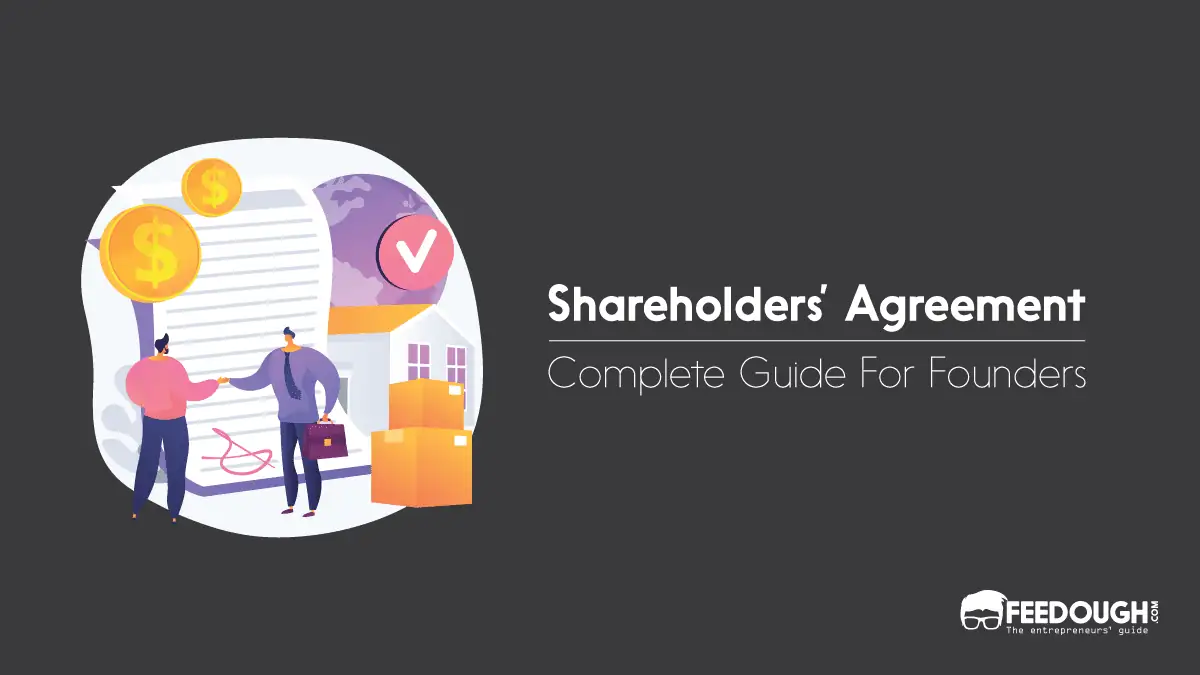If you own shares in a firm, you have a vested interest in the success of the firm. But what happens if the shareholders disagree or key investors wish to sell their shares to your competitor? You may face other challenges as well. It is where a well-drafted shareholder agreement comes into play to safeguard your interests.
It provides security and helps you avoid costly mistakes by ensuring everyone is on the same page and protecting your rights and interests.
This guide will delve into the nitty-gritty of a shareholder agreement and its significance. It will deal with the essential clauses you should include ensuring that your company’s agreement meets your requirements.
By the end of it, you’ll have a solid understanding of what it takes to create a strong and effective shareholders’ agreement. So, let’s get started!
A shareholders’ agreement (SHA) is a legally enforceable contract entered into by the shareholders of a company that outlines each shareholder’s rights, responsibilities, and obligations.
It describes the shareholder’s rights and duties and the rules for decision-making, transfer of shares, management, and other essential company matters.
An SHA is essential for any company with several shareholders because it can assist in preventing disputes, clarify decision-making procedures, and safeguard all interests.
However, you should know that the shareholders’ agreement differs from your company’s articles of incorporation and bylaws. These documents lay the groundwork for your company’s fundamental structure. But, the shareholders’ agreement focuses on your relationships with the other partners and the company.
For instance, you and your friends cofounded a company. You each own a share of the business. You may have different ideas about running it. You may wish to focus on developing the company, while others want to continue with current products. Disagreements and legal issues might result from these gaps.
It is where a shareholder agreement comes into play. It is a method of avoiding such disputes by providing clear criteria for the decision-making and administration of your company.
A shareholders’ agreement is essential to avoid potential difficulties when you’re forming a company with multiple shareholders. It is necessary because of the following reasons:
- Prevents disputes: A shareholders’ agreement helps prevent disputes among the shareholders from increasing by defining guidelines for decision-making and management of the company.
- Protects shareholders’ interests: The agreement can safeguard all the shareholders’ interests by specifying what happens if one of the shareholders wishes to sell their shares or if the company is sold to a third party.
- Clarifying decision-making processes: The agreement might stipulate how significant decisions would be made and how much power each shareholder has over such decisions.
- Provides flexibility: The agreement may be adjusted to the company’s and the shareholders’ requirements, allowing for greater decision-making freedom.
- Avoids costly legal fights: By describing how conflicts should be settled, the agreement can help prevent expensive legal battles, which can drain the company’s resources and ruin relationships with the shareholders.
When drafting a shareholders’ agreement, several provisions should be included. Here are some important conditions you need to keep in mind:
The company’s shareholders have certain perks. The shareholders can vote for essential decisions, such as who gets to join the company’s board of directors. They are entitled to receive dividends, a share of the company’s profits. Moreover, they also have the right to stay informed about the company’s activities.
Voting Rights
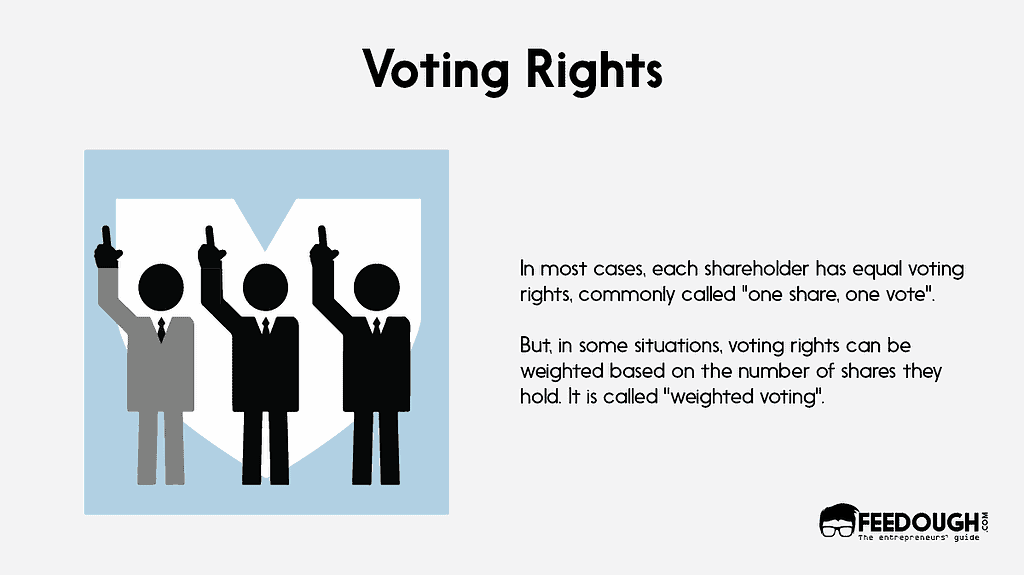
Voting rights are the shareholders’ fundamental rights that allow them to participate in the company’s decision-making and have a say in its operations. It will enable them to vote on issues such as electing the board of directors or approving significant company decisions.
In most cases, each shareholder has equal voting rights, commonly called “one share, one vote”.
But, in some situations, voting rights can be weighted based on the number of shares they hold. It is called “weighted voting”.
Let’s consider a company has three shareholders – A, B, and C. If the company follows a one-share, one-vote system, each shareholder would have an equal say in decision-making.
However, in a weighted voting system, the shareholders’ voting power would be determined by other factors. For example, the shareholders agree to give Shareholder A a weighted vote of two votes per share due to their significant contribution to the company’s growth. Shareholders B and C are given a weighted vote of one vote per share. Here, Shareholder A would substantially influence the company’s decisions. It is because their votes would hold more weight than the other shareholders.
Another method of distributing voting rights is implementing a tiered system where varying classes of shares possess different levels of the voting power.
For instance, some shares may be allotted ten votes per share, while others only receive one vote per share. This practice is commonly observed in firms with shareholders like founders, investors, or employees.
Thus, you should know how voting rights are distributed in your company since it can affect crucial company resolutions.
Information Rights
The shareholders have the right to receive specific information about the company, such as the financial statements or minutes of board meetings. Information rights are necessary as it enables them to stay informed about the company’s activities and financial performance.
Let’s say the company doesn’t perform well financially in a particular year. Shareholders can refer to the financial statements to evaluate the company’s performance and decide whether to keep or sell their shares. Moreover, suppose the board makes an important decision that could impact the company’s future. In that case, shareholders can review the board meeting minutes to comprehend the reasoning behind the decision. Then, they can determine if it was the best move for the company and its shareholders.
Rights To Dividends and Distributions
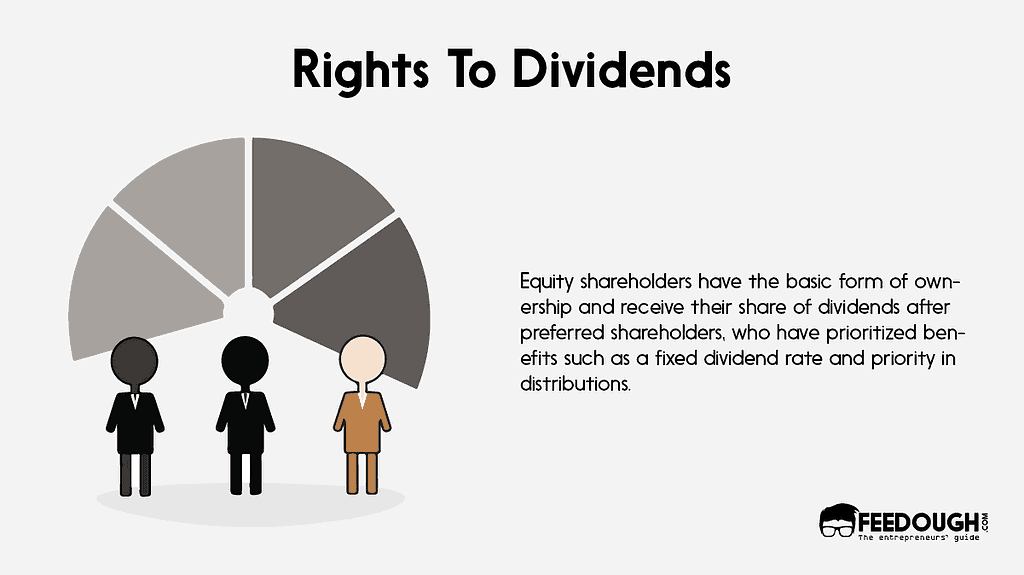
You also have the right to receive dividends and other distributions when your company makes a profit.
Thus, as a shareholder, you must know the difference between equity and preferential shares when dividends and other benefits are distributed.
Equity shareholders can possess certain privileges, such as the right to vote and receive a portion of the company’s profits through dividends. They are also known as “common” shareholders, as they have the company’s most basic form of ownership. When dividends are distributed, equity shareholders usually receive their shares after preferred shareholders have been paid.
However, preferential shareholders are prioritised when distributing dividends and other benefits. They enjoy benefits such as a fixed dividend rate and priority even when receiving distributions in case of liquidation of your company.
For example, the company has both preferred and equity shareholders. Preferred shareholders are entitled to a fixed dividend rate of $1 per share, but equity shareholders are not. Say the company makes a $10,000 profit. In that situation, it will first pay $1,000 to preferred shareholders at a fixed dividend rate of $1 per share (considering there are 1,000 preferred shares outstanding). The remaining profit of $9,000 will be distributed to equity shareholders as per the number of shares they own. For example, if there are 10,000 outstanding equity shares and a shareholder owns 1,000, the dividend payment will be $900 (i.e., $9,000 divided by 10,000 shares multiplied by 1,000 shares).
Pre-Emptive Rights
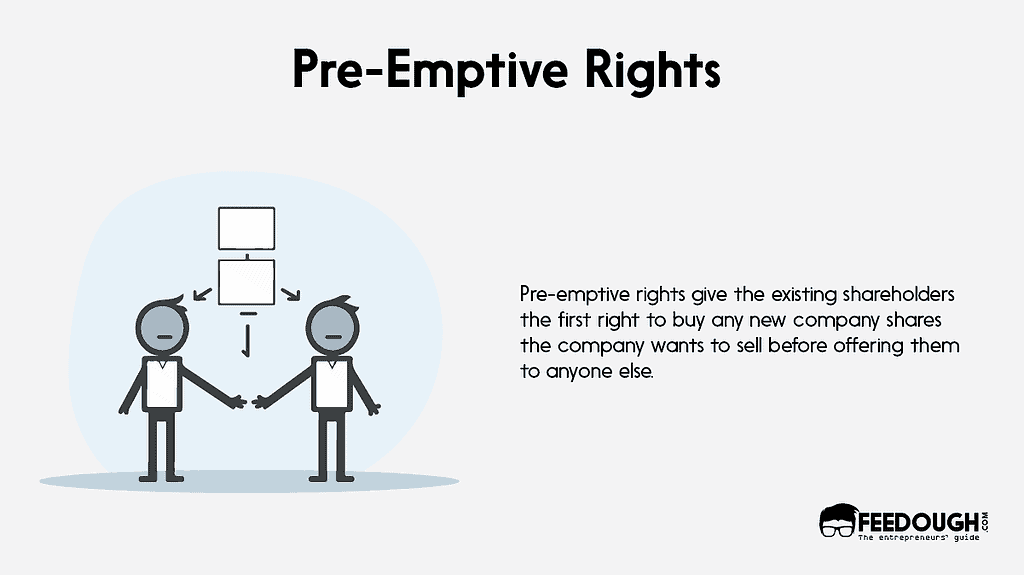
Pre-emptive rights give the existing shareholders the first right to buy any new company shares the company wants to sell before offering them to anyone else.
The pre-emptive rights are included in the shareholders’ agreement to safeguard the ownership of the present shareholders of the company. If such rights are absent, the new investors can purchase many company shares, potentially controlling and limiting the current shareholders’ say in the management.
For instance, let’s say the company issues new stocks. So, because of the pre-emptive rights, the existing shareholders are offered to buy the new shares first. They get the first preference to buy the new shares if willing. Then, the remaining shares are sold to others.
Vesting Rights
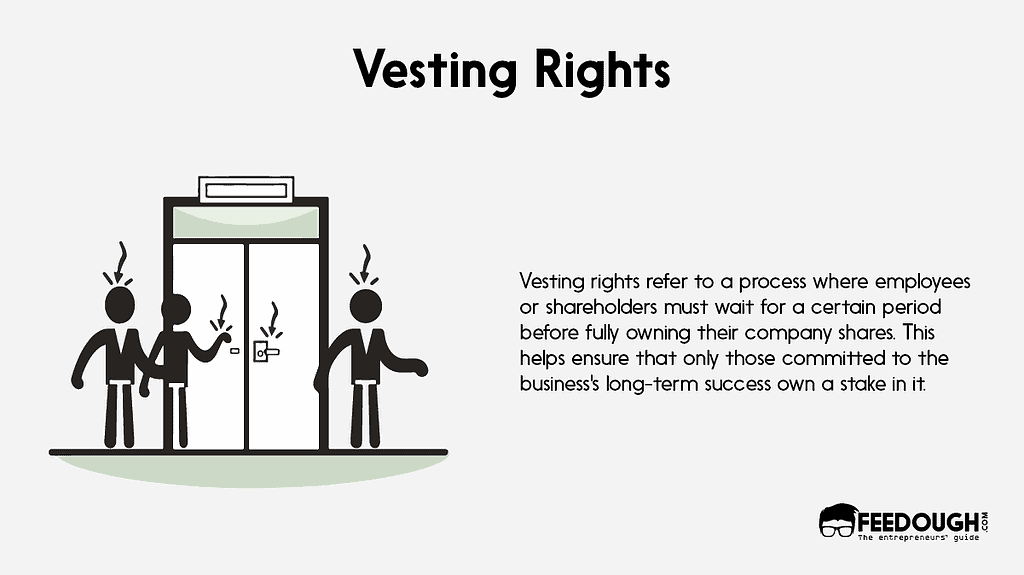
Vesting rights mean that the employees or the company shareholders must work or keep their investment for a certain period before fully owning their company shares. It helps ensure that everyone who owns a stake in the business is committed to its long-term success.
For example, a few employees are hired and are given 1,000 shares of the company. But instead of giving them all 1,000 shares up front, they are given the right to “vest” those shares over a period of time, such as four years. It means the employee only wholly owns the company’s shares only after working for the company for four years. Doing this ensures that the employee is committed to the company for the long term. If they leave before the four-year period ends, they will only have the right to keep a portion of the shares. The remaining shares will be returned to the company and distributed to someone else.
It helps protect the company’s interests by ensuring that only those committed to the business’s long-term success own a stake in it. It also incentivises the employees to stay with the company and work hard to make it successful.
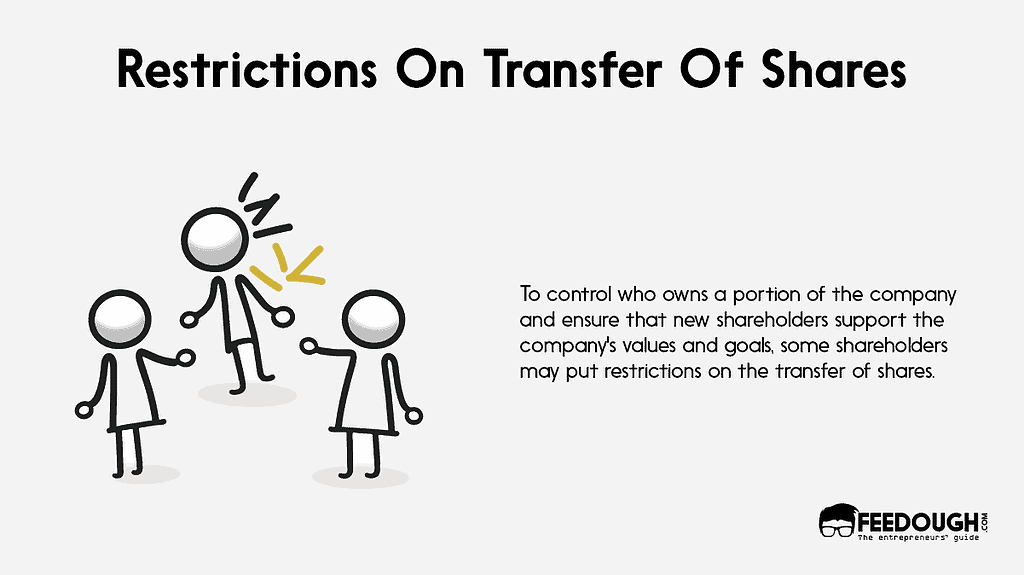
Some company shareholders may sometimes seek to sell their shares to someone else. But, it should be controlled who owns the company’s portion should be controlled and ensure that the new shareholder supports its values and business goals.
It is when restrictions on the transfer of shares come into play. These clauses can be added in the shareholders’ agreements to restrict the transfer of shares to specific people or companies or may need the consent of the other shareholders before a transfer can occur.
Let’s say that a company has four shareholders, A, B, C and D. The shareholders have a shareholder agreement that restricts the transfer of shares without the consent of the other shareholders. A potential buyer approaches shareholder A and shows interest in acquiring his shares. But, according to the restriction clause, A can only transfer his shares with the consent of B, C, and D.
Thus, before proceeding with the transaction, A must consult with his fellow shareholders and seek their approval. If they agree, A can sell his shares to the prospective buyer. If they disagree, A must maintain his shares or reach a different deal with the possible buyer.
The company’s shareholders must act in the company’s best interests and avoid conflicts of interest. In addition to their rights and obligations, the shareholders have fiduciary duties towards the company and each other.
These duties include:
- Duty of Loyalty: Shareholders must act in the company’s best interests and not use their position to benefit themselves at the company’s expense. For example, suppose a shareholder can access confidential information about the company’s plans to acquire a new business. In that case, they cannot use that information to buy shares in the new business before the company can do so.
- Duty of Care: They must exercise reasonable care and diligence as shareholders when making decisions related to the company. It means they must consider the potential impact of their decisions on the company and its other shareholders, including employees and customers. They should also stay informed about the company’s activities and financial performance.
- Duty of Good Faith: Shareholders must also act honestly and in good faith in their dealings with the company and other shareholders. They should not engage in illegal or fraudulent activities that could harm the company or other shareholders. For example, shareholders should not misrepresent their shares’ value to deceive potential buyers.
If they fail, legal action can be taken against them.
Management and Decision-Making
A shareholders’ agreement not only specifies the rights and duties of shareholders but also sets the company’s governance and decision-making structure. It includes the board of directors’ composition, director appointment and removal, and decision-making processes.
Board of Directors

Directors are essential to a company’s success since they manage its operations. When grouped, they form the company’s ‘board’.
Each type of director on the board has a distinct function to perform and brings a wide range of perspectives to the company.
- Executive Directors: An executive director of the company oversees the business and handles daily management tasks. For example, the company’s CEO is known for their comprehensive knowledge of the company, including its strategy and goals.
- Non-Executive Directors: A non-executive director is not involved in the company’s day-to-day operations. They are usually chosen for their expertise in the industry or their past track record of successfully managing a similar business.
- Representative Directors: When a shareholder wants to have their interests represented, they can appoint a representative director who will act on their behalf. It is a common practice for someone with a significant ownership stake in the company. They are also invested in the company’s success.
Appointment and Removal of Directors
It is crucial to decide who has the power to appoint and remove the company’s directors to avoid future conflicts. Since the directors determine most company decisions, understanding who can make their appointment is essential.
Hence, including this information in the shareholders’ agreement is essential, describing the rules and limitations for appointing and removing directors.
Appointment of Directors
The shareholders’ agreement stipulates who has the power to appoint directors. The following are standard methods for appointing the company’s directors:
- Appointed by the Board: The shareholders’ agreement should clearly state how many votes are needed for the board to bring in more directors during a board meeting. The required votes could be a simple majority, i.e., 50% or more in favour.
Suppose the company has a shareholder agreement that requires a two-thirds majority vote for significant company decisions, like hiring new directors. During a board meeting, the board suggests hiring two new directors to help in the company’s expansion plans. The shareholders vote on the proposal, receiving a 66% vote in favour of the decision. As the required threshold was two-thirds, the proposal passed successfully, and new directors were hired. However, if the vote in favour was just 60%, the proposal would have failed to meet the necessary threshold, and the company would have been unable to bring in the new directors. - Appointed by the Founders of the Business: The company’s founders can also serve as directors to maintain their control. The shareholders’ agreement gives them the right to appoint a director to secure their authority in the company. It means that even if their shareholding is diluted or they sell some shares, they will still have a say on the board.
Moreover, the founder can appoint a director if they have a certain percentage of shares, say 10%. However, if their share percentage drops below this threshold, they must resign as directors. - Appointed by Shareholders: The shareholders have an entrenched right to appoint a director. It is crucial for shareholders with a significant stake in the company, as it allows them to influence its decisions. The shareholders’ agreement outlines that shareholders holding a specific amount of shares, for example, 20% or more, are eligible to appoint a director.
Removal of Directors
A shareholders’ agreement specifies when and how directors can be removed from their position. It can be as follows:
- Voluntary Resignation: If a director wishes to step down, the shareholders’ agreement should state that they can do so by giving written notice to the company.
- Board’s Decision: The shareholders’ agreement should specify if the board can remove directors by a majority vote or if higher approval is needed. It typically applies to directors appointed by the board.
- Appointing Shareholder’s Decision: If a specific shareholder appointed a representative director, the shareholders’ agreement should state that only that particular shareholder can remove the director. It is known as an entrenched right to appoint a director.
- Shareholders forcibly remove the Director: It’s essential to have a plan in place for when shareholders need to remove a director forcibly. The shareholders’ agreement should clearly outline the circumstances in which this can occur.
Voting Rights of Directors
The company’s board of directors is responsible for making significant business decisions. As a shareholder, you should ensure that the board operates effectively and that decisions are made in the company’s best interests.
The shareholders’ agreement includes provisions that outline the voting rights of directors and how the board makes decisions.
For example, the agreement may require a majority vote of the board to make certain decisions, such as approving a budget or hiring a new executive. It ensures that decisions are made with the support of the majority of the board rather than by a single director.
In addition, the shareholders’ agreement gives certain directors a veto over certain decisions.
For instance, the agreement may require unanimous approval from the board before making a significant investment or acquiring another company. It gives each director a voice in decision-making and ensures that important decisions are carefully considered.
Meetings and Quorum
Board meetings are essential for the company’s operations. The directors come together to discuss and decide the company’s future. The shareholders’ agreement outlines the requirements for these meetings. It specifies the frequency of board meetings, which could be monthly, quarterly, or bi-annually, among other options.
The shareholders’ agreement also specifies the notice required for board meetings. The notice period is the time frame within which the directors must be informed of the upcoming meeting. It states how far advance notice should be given, such as 14 days, 30 days, or any other duration deemed appropriate by the parties involved.
The agreement also outlines the quorum required for board meetings. A quorum refers to the minimum number of directors present at a meeting to be valid. The quorum is typically calculated as a percentage of the total number of directors on the board. For instance, a quorum of 50% would require at least half of the directors to be present at the meeting.
For example, the shareholders’ agreement requires that board meetings be held at least once every quarter, with at least two weeks’ notice provided to all directors. The quorum necessary for the meeting is set at a majority of the total number of directors.
If there are five directors in total, then the quorum for a board meeting would be three directors. It means that at least three directors must be present at the meeting to be valid and for any decisions made to be binding. Still, they should also meet other requirements in the shareholders’ agreement.
However, if only two or fewer directors were present, the meeting would not be valid, and decisions could not be made.
Decision-Making Processes
When the company has a board of directors, it’s essential to establish clear decision-making processes. The shareholders’ agreement stipulates the different types of resolutions the board can pass, such as ordinary, special, and unanimous resolutions.
An ordinary resolution is a decision that requires a simple majority vote of the directors who are present at a board meeting. This resolution form is used for routine matters, like approving prior meeting minutes.
A special resolution is a decision that demands greater support from the directors. It requires at least two-thirds of them to vote in favour of it during a board meeting. Special resolutions are reserved for significant matters like amending the company’s articles of incorporation or approving substantial capital expenditures.
A unanimous resolution is a decision that requires the support of all directors who are present at a board meeting. This type of resolution is used for critical decisions, such as authorising a merger or acquisition.
Suppose a company’s board of directors is considering a significant business decision, such as acquiring another company. The shareholders’ agreement may specify that such a decision may require a special resolution that demands higher votes than a regular resolution. The shareholders’ agreement may also state that the special resolution requires the consent of a specific proportion of the board, like two-thirds of the directors.
For instance, in a board of nine company directors, at least six directors should vote in favour of the acquisition for the special resolution to be approved. However, a regular resolution, like validating the annual budget, may only need a simple majority of the board. It means that it requires only more than half of the directors should vote to pass the resolution.
Deadlock Provisions
Deadlock clauses guarantee that the business continues to run successfully even when the shareholders cannot agree on an issue and are at a standstill. The company might become paralysed when discussions or negotiations cannot address shareholder disagreements. The company cannot make any decisions or take any necessary measures.
Thus, the deadlock provisions can be included in the shareholders’ agreement to address this issue. It outlines a process for resolving disputes when the shareholders cannot agree. It can involve appointing a third-party mediator to help the parties reach a mutually acceptable resolution.
By having a clear and agreed-upon process for resolving disputes, the shareholders can avoid costly legal battles and minimise disruptions to the company’s operations.
Suppose a company has two shareholders, each owning 50% of the shares. They disagree over a significant decision, such as selling the company. Both shareholders have different opinions and cannot agree, resulting in a deadlock.
The shareholders’ agreement that they had signed had specified that a third-party mediator be brought in to help facilitate a resolution to resolve the deadlock. Thus, the mediator may work with both shareholders to identify potential solutions and help them negotiate a mutually acceptable outcome.
But, if the mediator could not facilitate a resolution. In that case, the shareholders’ agreement should provide other dispute resolution mechanisms, like binding arbitration or litigation, to help resolve the issue and prevent the company from being paralysed by the deadlock.
The shareholders’ agreement includes the transfer of shares, which refers to the process of buying and selling shares in the company. It also outlines types of transfers, right of first refusal, drag-along and tag-along rights, shotgun provisions and valuation of shares.
Types of Transfers
When it comes to transferring shares, several options can take place. They are as follows:
- Sale to a Third Party: Sale to a third party occurs when a shareholder sells shares to someone outside the company. It can happen for various reasons, such as the shareholder needing to raise funds or wanting to cash out their investment.
- Gifts to Family Members: A gift to a family member is when a shareholder gives some or all of their shares to a family member as a gift. It can be done for estate planning purposes or to pass on ownership of the shares to a family member interested in the business.
- Transfers to Trusts or Estates: In transfers to trusts or estates, a shareholder may transfer their shares to a trust or estate for estate planning or tax purposes. It can help ensure the shares are managed and distributed following the shareholder’s wishes.
- Inheritance: Inheritance is the type of transfer that occurs when a shareholder passes away, and their shares are passed on to their heirs or beneficiaries. In this case, the shares get transferred to the beneficiaries through probate or according to the shareholder’s estate plan.
Right of First Refusal
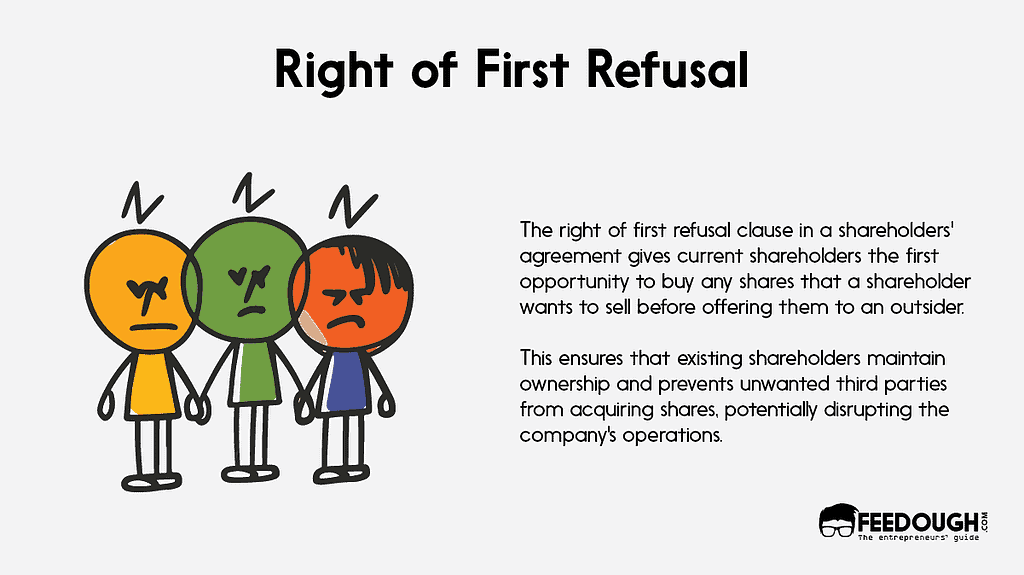
The right of first refusal clause in the shareholders’ agreement ensures that the current shareholders have priority in buying any shares that a shareholder wishes to sell before selling them to an outsider. It ensures that ownership of the company remains within the existing shareholder group, and a third party cannot become a shareholder without the consent of existing shareholders.
Thus, the clause is evoked when a shareholder decides to sell their shares. They must first offer them to other shareholders at a price agreed upon mutually or determined by an independent third-party valuation. If the current shareholders choose not to purchase the shares, the selling shareholder can sell them to a third party.
For instance, A and B own 50% of a company’s shares and have a shareholders’ agreement. It includes the provision of the right of first refusal.
A decides to sell her shares for $100,000 to a third party, but before doing so, she must offer them to B at the same price according to the agreement. If B declines, then A can sell them to a third party.
However, if B chooses to exercise her right of first refusal, she can buy A’s shares at the same price. The transaction would involve A transferring her shares to B and B paying $100,000 to own 100% of the company shares.
The right of first refusal clause in the shareholders’ agreement can benefit the existing shareholders in several ways. For example,
- It ensures that the shares remain within the group of existing shareholders, which can help to maintain the balance of power within the company.
- It can prevent unwanted third parties from acquiring shares and potentially disrupting the company’s operations.
- It helps maintain the company’s culture and values by ensuring that new shareholders align with the existing shareholders’ vision.
Drag-Along and Tag-Along Rights
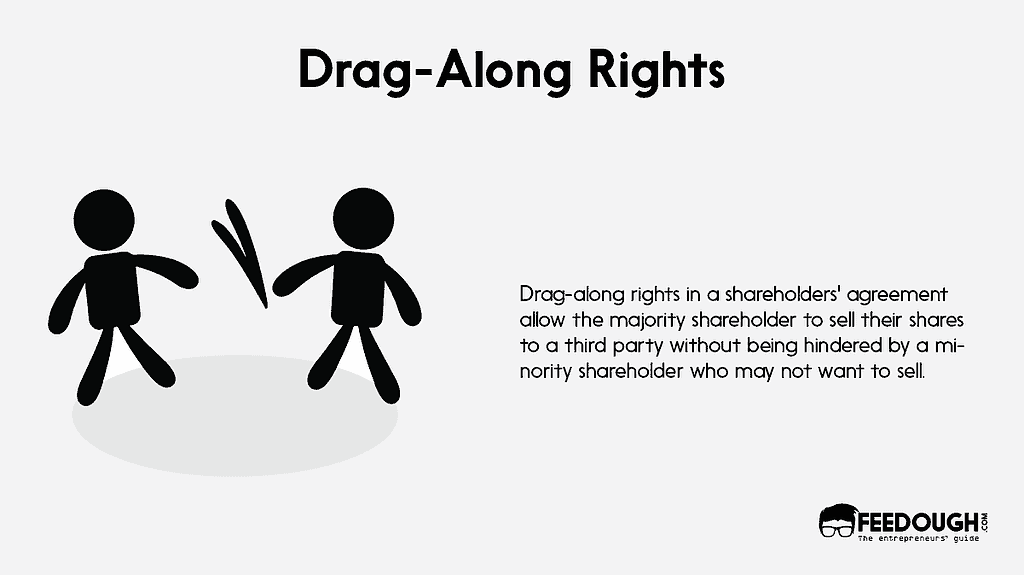
Drag-along and tag-along rights are essential provisions that protect the interests of majority and minority shareholders in the company.
Drag-along rights in the shareholders’ agreement ensure that the majority shareholder can sell their shares to a third party without being hindered by the minority shareholder, who may not want to sell their shares. Essentially, the majority shareholder has the right to “drag along” the minority shareholder in the company’s sale, compelling them to sell their shares. It can benefit both parties as it can help facilitate a sale and provide liquidity for the shareholders.
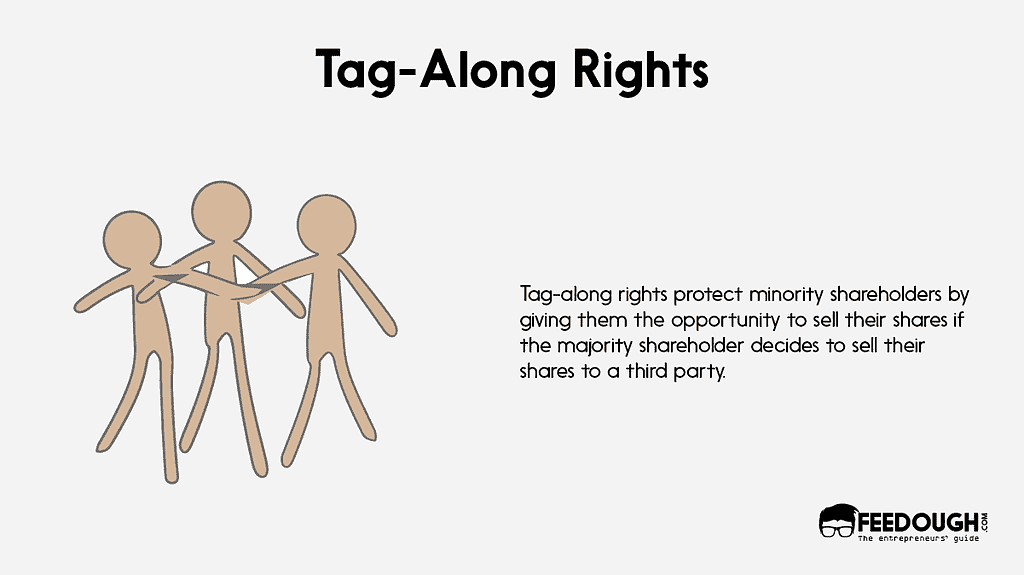
On the other hand, tag-along rights protect minority shareholders by allowing them to participate in a sale if the majority shareholder decides to sell their shares to a third party. It implies that if a majority shareholder is selling their shares, the minority shareholder has the right to “tag along” and sell them at the same price and on the same terms as the majority shareholder. It can benefit minority shareholders by ensuring they receive fair share value and are not excluded from the sale process.
Let’s say that Company A has three shareholders X, Y, and Z. X owns 60% of the company, while Y and Z each own 20%.
X receives an offer to sell their shares to Company B. However, Company B wants 100% ownership of Company A to proceed with the transaction. X could use his drag-along rights to force Y and Z to sell their shares so that Company B can acquire 100% ownership of Company A. However, if X did not have drag-along rights, Y and Shareholder Z could block the sale by refusing to sell their shares.
On the other hand, if Y and Z have tag-along rights and X decides to sell their shares to Company B, shareholders Y and Z could exercise their tag-along rights. They can then sell their shares alongside X, ensuring that they receive the same sale price per share.
With tag-along rights, Y and Z can sell their shares at a lower price if they can find a buyer willing to pay the same price as Company B.
Shotgun Provision
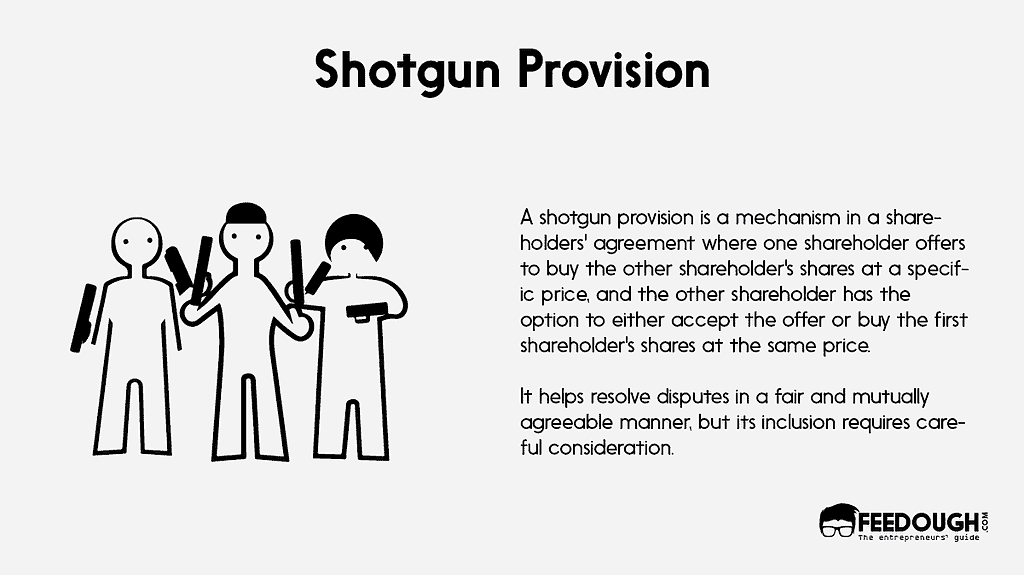
The basic idea behind a shotgun provision is that one shareholder offers to buy the other shareholder’s shares at a specific price. It is a type of dispute resolution mechanism included in the shareholders’ agreement to help resolve shareholder’s disputes. The other shareholder then has the option to either accept the offer or buy the first shareholder’s shares at the same price. This mechanism intends to treat both parties fairly. It encourages them to come to a mutually agreeable resolution, as neither party can be forced to buy or sell shares at a price they don’t agree with.
However, it is essential to note that shotgun provisions are complex and may only sometimes be appropriate for some situations. Thus, shareholders must consider all their options carefully before including a shotgun provision in their agreement.
For example, two shareholders, A and B, each own 50% of a company. They disagree about the company’s direction and cannot agree. Suppose their shareholders’ agreement includes a shotgun provision. In that case, A could offer to buy B’s shares at a specific price. B would then have the option to accept the offer and sell his shares to A or buy A’s shares at the same price. If B believes the company is undervalued and his shares are worth more than the offered price, he may buy A’s shares instead of selling his own. On the other hand, if B agrees with the provided price or believes that the company is overvalued, he may choose to sell his shares to A. This process can help both parties come to a resolution in a relatively quick and fair manner.
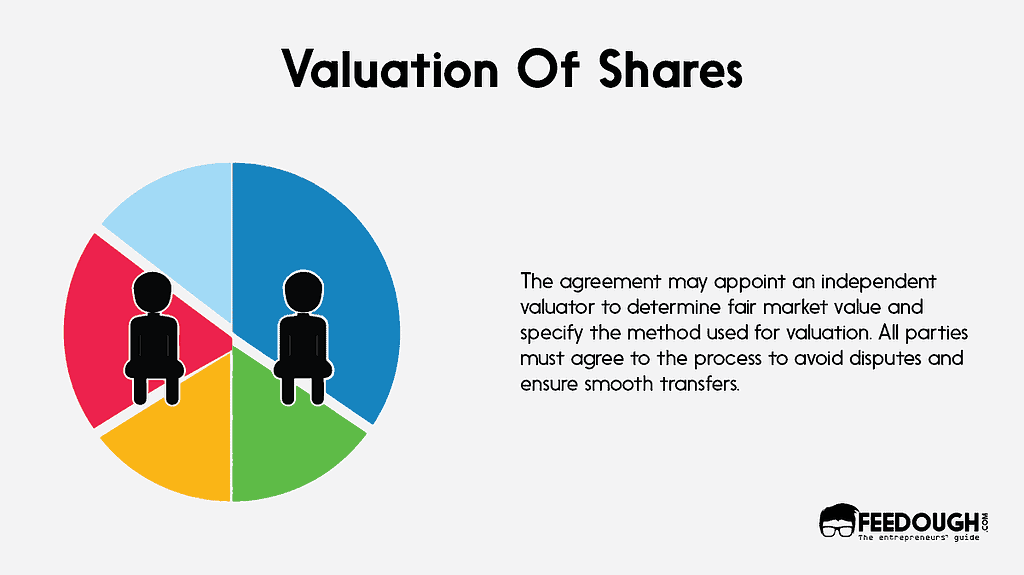
When a shareholder wants to transfer their shares, it’s crucial to determine the fair market value of the shares to ensure that the transfer is equitable for all parties involved. Thus, the shareholders’ agreement clarifies how the valuation process is conducted. One option is to appoint an independent valuator to determine the fair market value of the shares. The agreement also specifies the qualifications and selection process for the independent valuator.
Additionally, the agreement outlines the method for determining the value of the shares. For this, several ways are used, such as the company’s book value, the price-earnings ratio of the company’s stock, or the discounted cash flow method. Hence, the agreement specifies the technique used and the value’s calculation.
A clear process for determining the value of shares can help avoid disputes and ensure that transfers are conducted fairly and smoothly. So, all parties must understand and agree to the valuation process outlined in the shareholders’ agreement to provide clarity and understanding.
Let’s say that a company has two shareholders, A & B . They have a shareholders’ agreement that includes a provision for valuing shares in the event of a transfer. The agreement states that an independent valuator will be appointed. He will determine the share’s fair market value based on factors like the company’s financial performance, industry trends, and comparable transactions.
Suppose A wants to sell his shares to a third party. In that case, he must first offer them to B at the fair market value determined by the independent valuator. If B declines to purchase the shares, A can sell them to a third party at that same fair market value.
This provision helps ensure that both shareholders are treated fairly during a share transfer and prevents one party from receiving an unfair advantage in the transaction.
Exit Strategies
When shareholders invest in a company, they must also consider how to exit their investment when required. The shareholders’ agreement outlines various exit strategies available to the shareholders. It includes buy-sell provisions, mandatory buyouts, initial public offerings, and the sale of the company.
Buy-Sell Provisions
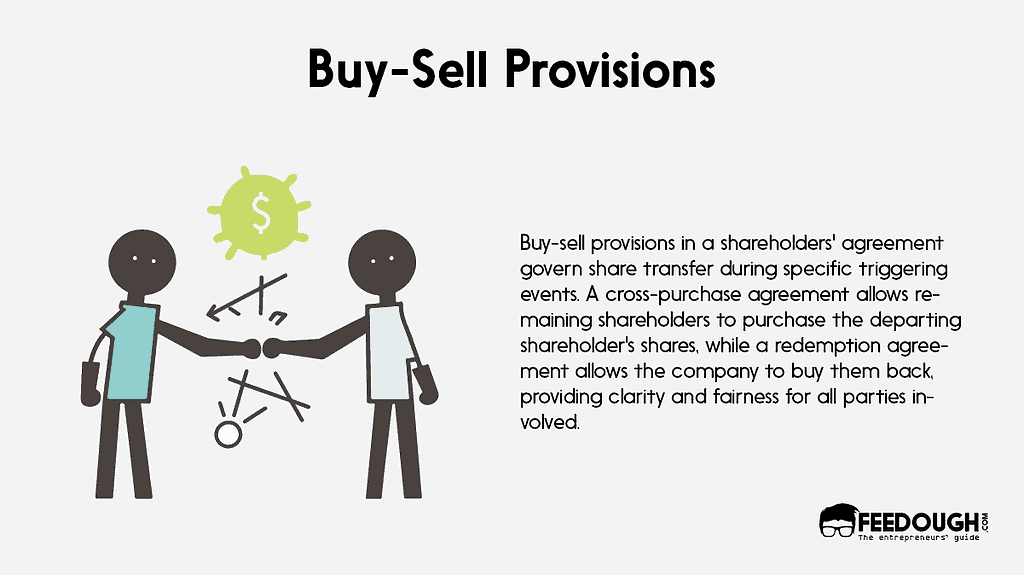
In some situations, buy-sell provisions are essential to a shareholders’ agreement that governs share transfer. These provisions allow shareholders to purchase shares from other shareholders under specific conditions, such as the death or incapacity of a shareholder or the termination of employment.
Two types of buy-sell provisions can be included in the shareholders’ agreement: a cross-purchase agreement or a redemption agreement.
In a cross-purchase agreement, the remaining shareholders purchase the departing shareholder’s shares in proportion to their ownership interests.
Let’s say that a company has three shareholders, A, B, and C, each owning 33.33% of the company’s shares. The shareholders have a cross-purchase agreement in place, which states that in the event of the death or incapacity of one of the shareholders, the remaining shareholders can purchase that shareholder’s shares. So, if A were to pass away, B and C would each have the option to acquire 16.67% of A’s shares.
On the other hand, in a redemption agreement, the company purchases the departing shareholder’s shares. This type of agreement is used when there are only a few shareholders, or the company has the financial resources to buy back the shares. In this case, the company would pay the departing shareholder the agreed-upon value of their shares.
Let’s assume the scenario above, but the shareholders have a redemption agreement now. If A were to pass away, the company would purchase 33.33% of the shares at a predetermined price. The remaining shareholders, B and C, would split A’s portion of the company’s equity.
Thus, the buy-sell provisions help ensure that shares are transferred reasonably and orderly during certain triggering events. They provide clarity and certainty for the remaining shareholders and the company.
Mandatory Buyouts
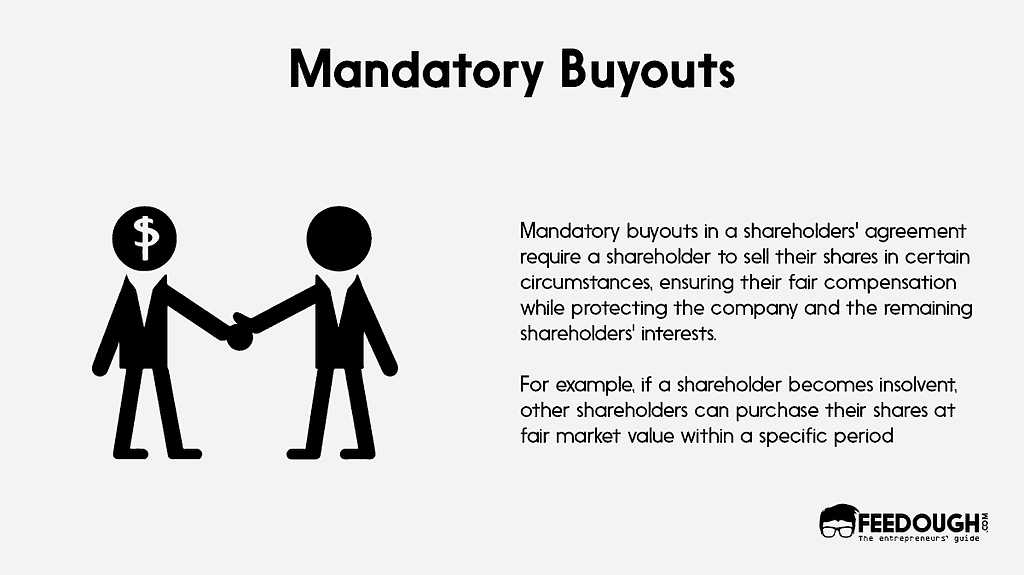
Mandatory buyouts are provisions in the shareholders’ agreement that require a shareholder to sell their shares in certain circumstances, as specified in the agreement. It may include a change of control of the company, a breach of the contract by the shareholder, or if the shareholder becomes insolvent. In such cases, the remaining shareholders or the company may have the right or obligation to purchase the shares at a predetermined price or based on a specified valuation method.
This provision address situation where a shareholder’s continued ownership of the shares may harm the company or the other shareholders.
For instance, there is a change of control of the company. A new owner takes over and has different goals and strategies. A mandatory buyout provision can help ensure the departing shareholder is fairly compensated for their shares while protecting the remaining shareholders and the company’s interests.
Similarly, suppose a shareholder violates the agreement by breaching the duty of loyalty or care. In this case, a mandatory buyout provision can allow the other shareholders to remove the offending shareholder and protect the company’s interests. It is vital when the shareholder’s actions may harm the company’s reputation or financial stability.
Finally, if a shareholder becomes insolvent, a mandatory buyout provision can help ensure the company’s shares are not tied up in bankruptcy proceedings. It can be sold to new investors who can help the company grow and succeed.
Thus, to give you an idea, suppose a company has three shareholders, A, B, and C. Their shareholders’ agreement includes a mandatory buyout provision. It states that if a shareholder becomes insolvent, the other shareholders can purchase their shares at fair market value within 60 days. So, if A becomes insolvent, B and C can exercise their right to buy A’s shares. A’s shares can be sold to a third party if they do not exercise this right within the 60-day window. This provision helps protect the company from the financial risks associated with a shareholder’s insolvency.
Initial Public Offerings
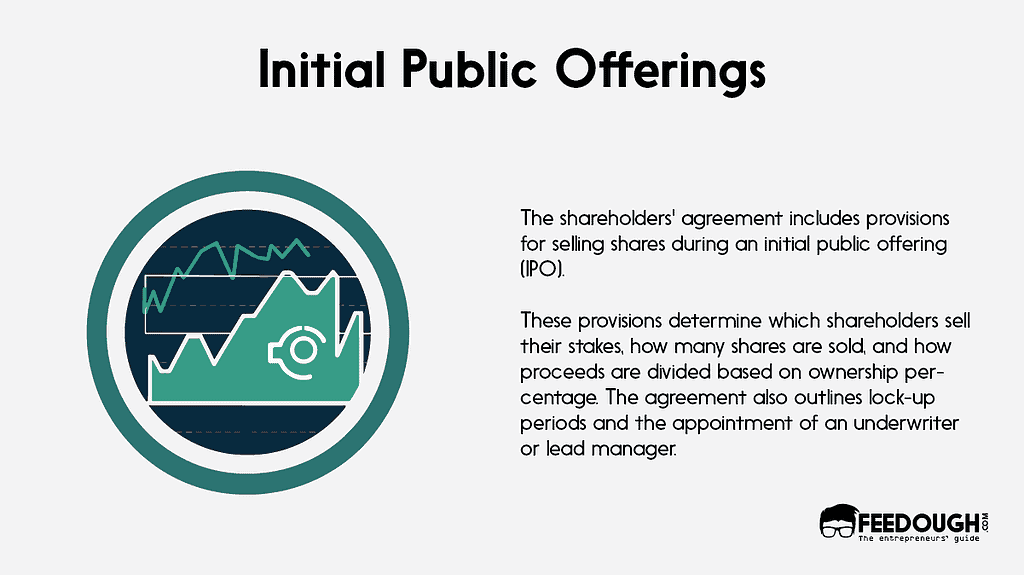
An initial public offering (IPO) is the procedure through which a privately owned firm first sells its shares to the general public. The company and its existing shareholders, including the founders and early investors, may sell part of their shares to the public during an IPO.
Thus, when a company decides to go public and have an initial public offering (IPO), the shareholders’ agreement includes provisions outlining the process for selling shares in the IPO. These provisions can address various issues, like who among the shareholders will be selling their stakes in the IPO, how many shares each shareholder will sell, and the pricing and allocation of the shares etc.
The provisions stipulate how the share sale profits will be divided among the shareholders. It specifies that all shareholders sell a certain percentage of their stakes in the IPO. Then, the proceeds will be distributed proportionally based on each stakeholder’s ownership percentage. The agreement also outlines different distribution percentages depending on seniority or investment amount.
Further, the provision also addresses other issues related to the IPO, like lock-up periods for shareholders, which restrict the ability to sell shares for a certain period after the IPO. It also mentions the appointment of an underwriter or lead manager to facilitate the sale of shares in the IPO.
Sale of the Company
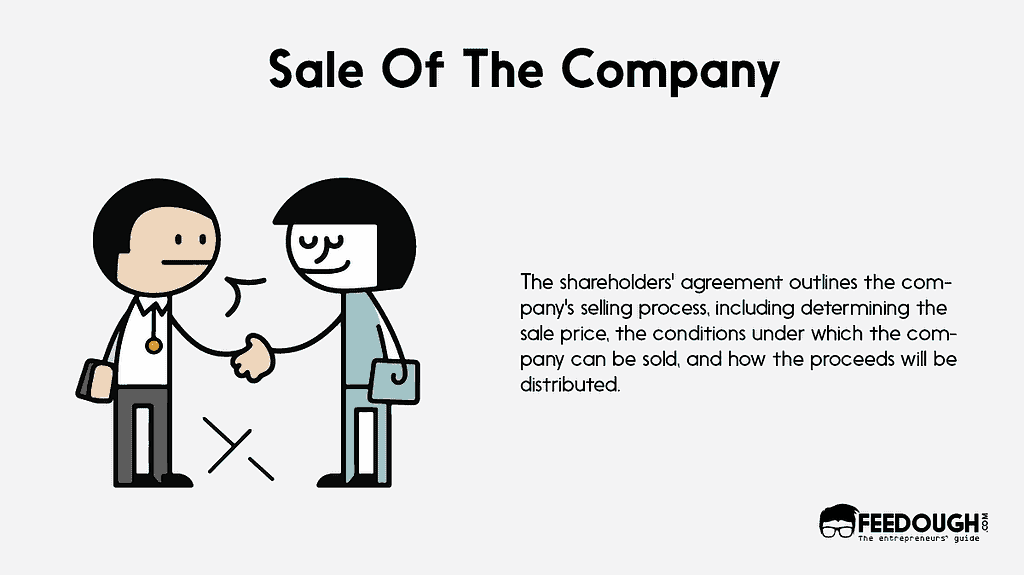
The shareholders’ agreement outlines the company’s selling process, including determining the sale price, the conditions under which the company can be sold, and how the proceeds will be distributed, such as based on each shareholder’s ownership percentage.
For example, the agreement may specify that a sale of the company can only occur if a certain percentage of shareholders agree to it or if a certain price threshold is met.
The agreement also provides for the appointment of a financial advisor or investment bank to assist with the sale process. It ensures that the interests of the shareholders are protected. Further, it also stipulates the roles and responsibilities of the parties involved in the sale.
Let’s say the shareholders’ agreement specifies that the company can only be sold if all shareholders agree to the sale. Suppose a potential buyer makes an offer to purchase the company. In that case, the shareholders must consider the proposal and decide whether to accept it. If all shareholders agree to the sale, the next step would be determining the sale price and how the proceeds will be distributed to shareholders. It may involve appointing an independent valuator to assess the company’s fair market value and then distributing the profits based on each shareholder’s ownership percentage. The agreement may also specify whether any shareholders have a right of first refusal to purchase the shares of other shareholders before they can be sold to a third party.
Dispute Resolution
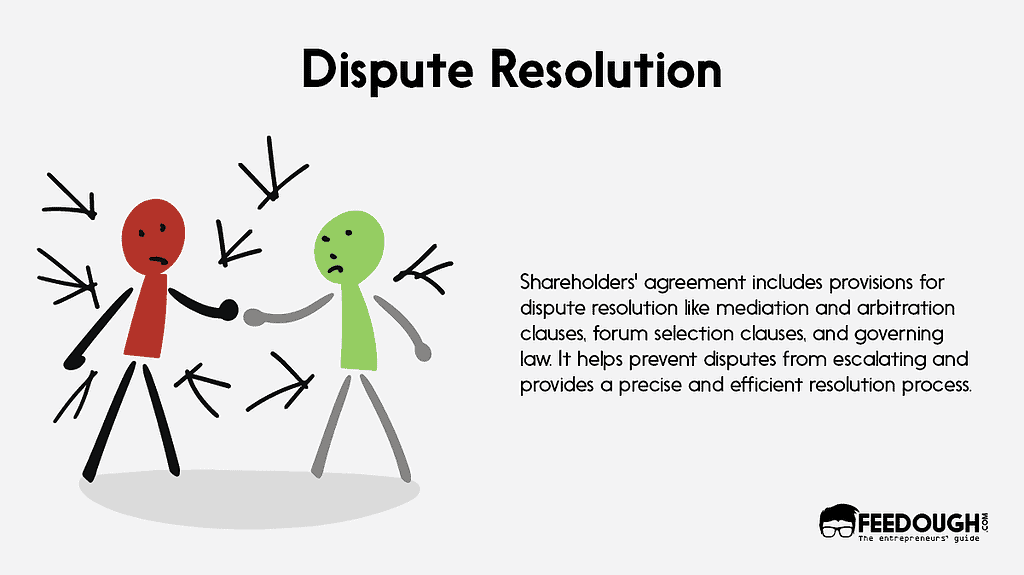
Disputes between shareholders can arise for various reasons, such as disagreements over management decisions, breaching the shareholders’ agreement, or conflicting business strategies. If not resolved promptly, these disputes can lead to significant financial losses and damage the company’s reputation.
A well-drafted shareholders’ agreement includes provisions for dispute resolution like mediation and arbitration clauses, forum selection clauses, and governing law. It helps prevent disputes from escalating and provides a precise and efficient resolution process.
Mediation and Arbitration Clauses
The shareholders’ agreement includes Mediation and Arbitration clauses that are alternative dispute resolution mechanisms. These clauses require the parties to resolve disputes through mediation or arbitration rather than a traditional court process.
Mediation is a non-binding process where a neutral third party, the mediator, helps the parties to reach a mutually acceptable resolution without going to court.
However, arbitration is a binding process where a neutral third party, the arbitrator, hears evidence and arguments from both parties and makes a typically final and binding decision. Usually, the arbitration happens in a place mutually agreed upon by the parties, as mentioned in the arbitration clause of the shareholders’ agreement, for instance, through the American Arbitration Association in Boston.
Including mediation and arbitration clauses in a shareholders’ agreement can provide several benefits:
- Faster and Cost-effective: It is a faster and more cost-effective way to resolve disputes than going to court, which can be time-consuming and expensive.
- Privacy and Confidentiality: It provides more privacy and confidentiality, as the proceedings are typically confidential and not open to the public.
- Tailored Approach to Resolving Disputes: It provides a more tailored approach to resolving disputes, as the parties can select a mediator or arbitrator with expertise in the dispute’s subject matter.
Let’s assume a company has three shareholders, A, B, and C. Suppose any dispute arises between A, B, and C regarding interpreting their shareholders’ agreement or any other matter relating to the company. In that case, the parties may agree to resolve the dispute through mediation. A mediator chosen by the parties will conduct mediation. However, if the parties cannot resolve the dispute through mediation, they may proceed to arbitration as the clause provides.
Forum Selection Clauses
Forum selection clauses in the shareholders’ agreement specify the jurisdiction and court where any disputes will be heard.
Incorporating these clauses in the shareholders’ agreement is beneficial for several reasons.
First, they can provide certainty and predictability for the parties involved in the agreement. By specifying the jurisdiction and court where disputes will be heard, the parties can avoid conflicts over which court has jurisdiction or where the case should be heard.
Additionally, forum selection clauses provide efficiency and cost savings. If the parties agree in advance on where disputes will be heard, they can avoid the time and expense of litigating that issue in court. It can also reduce litigation costs overall, as the parties can avoid the expense of litigating in multiple jurisdictions.
However, it’s important to note that forum selection clauses are not always enforceable. Courts may decline to enforce these provisions if they are deemed unfair or unreasonable or if enforcing them would violate public policy.
As such, it’s essential to ensure that any forum selection clause is drafted carefully and with the guidance of legal counsel.
Here’s an example of a forum selection clause for a fictional company called “TechCo”.
“Any dispute arising out of or related to this shareholders’ agreement, including but not limited to disputes regarding the interpretation, performance, or breach of this agreement, shall be resolved exclusively in the State of New York courts. The parties now submit to the jurisdiction of the State of New York courts. They agree that the venue for any such proceeding shall lie exclusively with the courts located in the State of New York.”
In this case, the clause states that any conflicts arising from the shareholders’ agreement will be tried solely in the State of New York courts. It gives the parties concerned clarity and assurance. It can assist in preventing disagreements about where possible legal procedures should occur.
Governing Law
The governing law provision in the shareholders’ agreement outlines the law used to interpret and enforce the agreement. This provision is essential because it provides clarity and consistency in legal disputes or issues between the shareholders.
For example, suppose the shareholders of a company are from different countries. In that case, it is necessary to choose a governing law that is neutral and widely accepted. The governing law provision includes a choice of law provision. It specifies that the governing law will be the law of a particular jurisdiction, regardless of where the shareholders or the company are located.
Having a clear and agreed-upon governing law provision in the shareholders’ agreement help prevent legal disputes and provide a framework for resolving conflicts. This provision also offers certainty and predictability for the shareholders, which can be crucial in maintaining a positive and productive working relationship.
Confidentiality and Non-Compete Clauses
The shareholders’ agreement can also include confidentiality, non-compete agreements, and intellectual property rights. These provisions can help protect the company’s trade secrets and intellectual property and prevent shareholders from competing with the company.
Confidentiality Provision
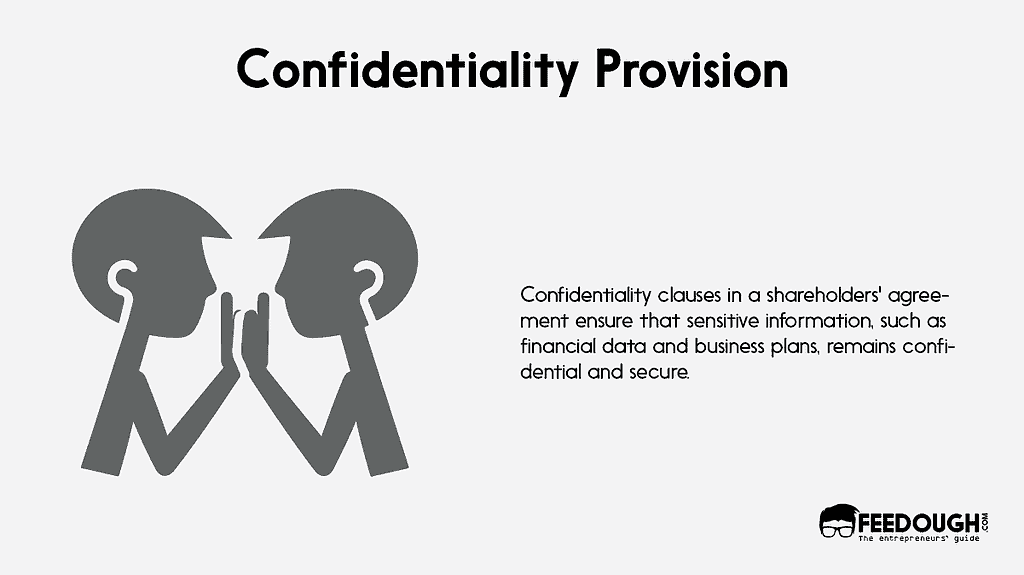
The confidentiality clauses in a shareholders’ agreement outline the specific types of information of the company that must be kept confidential by the shareholders and the consequences for breaching the contract.
It is essential to a shareholders’ agreement because it protects the company’s sensitive information. Shareholders may access confidential information such as financial data, business plans, customer lists, and other proprietary information that outsiders should not disclose. Thus, shareholders sign these agreements before becoming parties to the shareholders’ agreement.
Moreover, confidentiality agreements are tailored to the company’s specific needs.
For example, limiting the use of the information for a particular purpose, restricting the parties to whom the data can be disclosed, or requiring the return or destruction of confidential information upon the termination of the agreement.
Confidentiality agreements assure shareholders that their sensitive information will not be disclosed to competitors or other unauthorised parties. This way, the company protects its trade secrets and maintains a competitive advantage.
Let’s say that four shareholders, A, B, C and D, own a company. They have a shareholders’ agreement in place that includes a confidentiality provision. The provision requires each shareholder to keep confidential non-public information about the company, such as trade secrets, customer lists, and financial information.
The agreement also specifies how long the confidentiality obligation lasts, like during the shareholder’s ownership of the company and for a certain period after they sell their shares. It outlines the consequences of breaching the confidentiality provision, such as monetary damages or injunctions to prevent further disclosure.
Non-Compete Provision
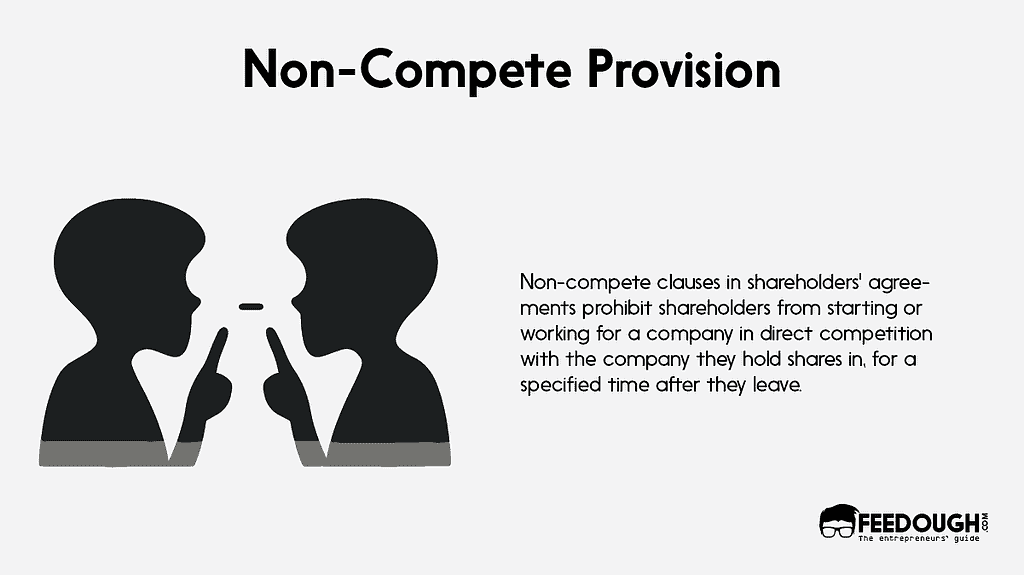
Non-compete clauses in the shareholders’ agreement restrict shareholders from starting or working for a company in direct competition with the company in which they hold shares. These provisions are usually in effect for a specified time after the shareholder sells their shares or leaves the company.
The non-compete agreements prevent shareholders from taking the knowledge and experience they gained while working for the company and using it to start or work for a competing company. It is essential for industries with fierce competition, where losing trade secrets or intellectual property can devastate the company.
It also protects the value of the company’s shares by preventing shareholders from starting a competing business that could diminish the company’s share values. It is imperative when the shareholder holds a significant portion of the company’s shares, and their departure could significantly impact its financial performance.
Thus, having non-compete agreements can provide the company and its shareholders with peace of mind, knowing that the value of the company’s shares and intellectual property is protected. However, it is vital to ensure that these provisions are carefully drafted and keep the shareholder’s ability to work in their field of expertise open after they leave the company.
Here’s an example of a non-compete agreement in a shareholders’ agreement:
“Shareholders agree that for two years following the sale of their shares, they will not engage in any business activity that competes with the company’s products or services within a 50-mile radius of the company’s headquarters. Shareholders recognise that such restrictions are necessary to safeguard the company’s trade secrets and confidential information and to ensure that it can maintain its competitive advantage in the marketplace.”
In this instance, the shareholders consent to limit their future opportunities in return for the perks of being a startup shareholder. The non-compete clause safeguards the startup’s intellectual property, trade secrets, and marketplace by prohibiting former shareholders from using the company’s knowledge to benefit a rival company.
Intellectual Property Rights
Intellectual property rights are essential to a company’s value. The shareholders’ agreement clarifies how the company owns and protects these rights. The agreement outlines which party owns any patents, trademarks, copyrights, or other intellectual property created by the company or its shareholders. It also includes provisions for registering and maintaining these rights.
Further, it addresses how the company handles intellectual property disputes, such as infringement claims or challenges to the validity of its patents or trademarks. It stipulates the process for resolving these disputes and designates specific individuals or entities responsible for managing them.
Hence, explicit provisions for intellectual property rights in the shareholders’ agreement prevent disputes and protect the company’s valuable assets. It can also provide a framework for addressing potential issues that may arise in the future.
Let’s say that a software development company has three shareholders A, B and C. In their shareholder agreement, they include a provision regarding intellectual property rights. The provision states that any intellectual property created by any shareholders during their work for the company will be owned by the company, not by individual shareholders. The shareholders will sign any necessary agreements or assignments to transfer ownership to the company.
Furthermore, the agreement specifies that the company will take appropriate measures to protect its intellectual property, including filing patents, trademarks, and copyrights where applicable. It also states that the shareholders will not use the company’s intellectual property for personal gain. They will not disclose confidential information about the company’s intellectual property to third parties and have restricted unauthorised access.
Termination and Amendment Clauses
The shareholders’ agreement includes Termination and amendment provisions. These provisions clarify how the agreement will be terminated and how it can be amended when required.
Termination Provisions
Termination provisions are essential to the shareholders’ agreement because they establish the conditions under which the agreement can be terminated. These provisions include several scenarios, like the company sale, dissolution, or a unanimous decision by all shareholders to terminate the contract.
For instance, during a sale of the company, the shareholders’ agreement may end or be transferred to the new owner. The agreement can specify that the new owner should assume all of the rights and obligations of the current shareholders under the contract. Any remaining obligations or rights under the agreement will pass to the company’s new owner.
Alternatively, it may also provide for the automatic termination of the agreement upon the sale of the company, with any remaining obligations or rights passing to the new owner.
When the company is dissolved, the agreement specifies how the remaining assets and liabilities will be distributed among the shareholders. The agreement may also require the appointment of a liquidator or other third party to oversee the winding-up of the company.
Furthermore, the agreement may also include provisions for terminating it by the shareholder’s mutual consent. It may involve a formal vote or another mechanism for obtaining unanimous consent to end it. The agreement may also specify the process for distributing any remaining assets or liabilities of the company in the event of mutual termination.
So, clear and comprehensive termination provisions in a shareholders’ agreement help ensure that all parties understand their rights and obligations in the event of a termination and can prevent disputes or misunderstandings.
Amendment Provisions
Amendment provisions are essential to ensure the shareholders’ agreement remains relevant and up-to-date. These provisions set out the process for making changes to the agreement, including the minimum number or percentage of shareholders required to approve any amendments.
For example, the amendment provision may require that a certain percentage of shareholders approve any agreement changes, like two-thirds or three-quarters of all shareholders. It ensures that any changes to the contract are made with the support of a significant majority of shareholders.
The provision also specifies the process for proposing and voting on amendments, such as requiring written notice of proposed changes to be given to all shareholders and setting a deadline for voting. It ensures that all shareholders have a fair opportunity to review and consider any proposed changes before approval.
Additionally, the provision requires that any amendments to the agreement must be filed with the appropriate regulatory authorities. And that all shareholders should be notified of any changes to the agreement on time.
Overall, the amendment provision is a vital component of the shareholders’ agreement as it ascertains that the shareholder agreement remains relevant and reflects the current needs and objectives of the shareholders.
SHA Tips and Suggestions
When drafting a shareholders’ agreement, it is crucial to seek legal advice to ensure that the agreement is enforceable and meets legal requirements.
Here are some tips and suggestions to consider when creating the shareholders’ agreement:
- Do your due diligence. Research and understand your jurisdiction’s legal requirements and regulations to create a shareholders’ agreement.
- Identify the key provisions that must be included, such as decision-making, transfer of shares, dispute resolution, and termination provisions.
- Keep in mind the company’s objectives and ensure the agreement reflects the company’s goals, objectives, and vision for the future.
- Make the agreement easy to understand by using clear and straightforward language.
- Include provisions for resolving shareholder disputes, such as mediation or arbitration clauses.
- Safeguard shareholder rights by including voting rights, dividend entitlements, and share ownership clauses.
- Address confidentiality and non-compete agreements to prevent shareholders from disclosing confidential information and competing with the company.
- Include provisions that outline how the company will own and protect intellectual property rights.
- Specify the governing law used to interpret and enforce the agreement and to ensure everything is clear.
- Review and update the agreement periodically to keep it relevant and up-to-date with any changes in the company’s objectives, shareholders, or legal requirements.
By following these tips and suggestions, you can create a well-drafted shareholders’ agreement that protects the interests of all shareholders and provides a clear roadmap for the company’s future.
Bottom-Line?
A well-drafted shareholders’ agreement is crucial for any company with multiple shareholders. It serves as a foundation for the company’s operations and helps protect shareholder rights, prevent disputes, and provide a clear path forward. It is essential to take the time to consider and address all necessary provisions in the agreement thoroughly and to seek legal advice to ensure its enforceability. Companies can establish a robust framework for their success and growth by creating a comprehensive and enforceable shareholders’ agreement.
Go On, Tell Us What You Think!
Did we miss something? Come on! Tell us what you think about our article on Shareholders’ agreement (SHA) in the comments section.
A lawyer and an avid reader with a keen interest in company laws. Anwesha has good experience of writing in the legal and startup industries for well over 10 companies. In her free time, you can find her reading fiction and stargazing.
